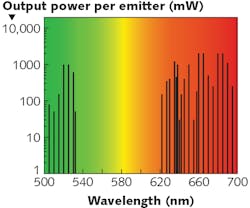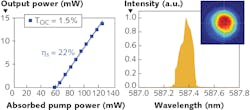Lasers & Sources: New diode-pumped solid-state laser emits in the yellow region

Currently, no common laser diodes are available that emit in the “green” gap between about 530 nm and 620 nm (see Fig. 1). However, a continuous-wave (CW) solid-state laser pumped by blue diodes and lasing in the yellow region at 588 nm has now been developed. The laser, which uses a lithium lutetium fluoride (LiLuF4) host crystal with oxygen-free crystal growth, is an important step toward compact and affordable lasers in the green gap.
Scientists at the Center for Laser Materials (ZLM) at the Leibniz-Institute for Crystal Growth (IKZ; Berlin, Germany) grew the new laser crystal and successfully tested its various laser emission lines. Pumped by a 200 mW indium gallium nitride (InGaN) laser diode at 487.5 nm, the laser produced 14 mW at 587 nm (yellow), limited only by the pump power. Furthermore, the laser achieved a 42 mW output in the green region at 542 nm with the same crystal.
The yellow laser showed a slope efficiency of 22%, which is the best performance from any directly yellow-emitting diode-pumped solid-state (DPSS) laser, the researchers say. The green laser reached an even-higher slope efficiency of 52% with respect to the absorbed pump power.
Applications of yellow lasers in medicine and astrophysics
Yellow laser emission is a key component for applications in diverse fields. In medicine, the strong absorption of hemoglobin in the yellow enables highly selective treatments in skin and eye surgery. For example, the treatment of vascular skin lesions uses yellow light as the “gold” standard. Here, small blood vessels in the face disappear after they are treated with appropriate doses of yellow light. The high absorption by hemoglobin makes the yellow wavelength also interesting for other biomedical applications, such as flow cytometry.
An important telescope-related application of yellow lasers relies on the absorption lines of sodium atoms at 589 nm. Such atoms form a thin layer around the earth at a height of about 90 km—these atoms can be excited by a yellow laser at the site of a large ground-based telescope, forming so-called laser guide stars high above the observatory. Wavefront deformation of the guide stars’ radiation caused by atmospheric turbulence is detected on the ground and used as the input for adaptive optics (AO) that correct the telescope’s incoming wavefront. This way, the sodium atoms enable unprecedented imaging quality for these large telescopes.
The astrophysicists use a sophisticated light source to excite the sodium atoms. According to its manufacturer, Toptica Photonics (Munich, Germany), it is a combination of a spectrally narrow diode laser at 1178 nm, a Raman fiber amplifier, and resonant frequency conversion to 589 nm. Other applications use Nd:YAG lasers with nonlinear frequency-conversion optics to produce yellow laser light. Higher powers have been produced using dye lasers, and high pulse energies using bulky copper bromide (copper vapor) lasers.
Fluoride is the key
For potential yellow DPSS lasers, there are unfortunately only a few active ions with suitable energy-level schemes. Dysprosium and samarium ions have shown laser emission in the yellow, but both are prone to cross-relaxation and other interionic processes that quench the lifetime and limit the maximum doping concentrations necessary for efficient laser operation.
In contrast, trivalent terbium (Tb3+) does not present any detrimental cross-relaxation channels or lifetime quenching, even at high doping concentrations. Tb3+ is known and well established as a brilliant lemon-yellow phosphor in fluorescent lamps and color TV tubes, and it exhibits strong emission lines in the green, yellow, and orange spectral range.
Still, for a long time Tb3+ was not considered a suitable candidate for laser operation due to its low absorption and emission cross-sections (caused by the relevant transitions being spin-forbidden). Moreover, it shows detrimental excited-state absorption from the upper laser level.
Using highly Tb3+-doped LiLuF4 as the gain material allowed the ZLM researchers to circumvent these limitations (see Fig. 2). The low crystal field strength of fluoride crystals strongly diminishes the detrimental excited-state absorption, and the high concentration of Tb3+ ions in this material compensates for the low absorption and emission cross-sections. The actual growing process is a particular challenge, as fluoride crystals must be grown in a completely oxygen-free atmosphere.The researchers expect that both the power and the efficiency of their laser can be further increased by boosting pump power and optimizing the crystal itself, as well as the pumping scheme.
REFERENCES
1. E. Castellano-Hernández et al., Opt. Lett., 43, 19, 4791–4794 (2018).
2. E. Castellano-Hernández et al., "Diode-pumped yellow laser emission of Tb3+:LiLuF4," in Laser Congress 2019 (ASSL, LAC, LS&C), OSA Technical Digest (Optical Society of America, 2019), paper ATu1A.8.
About the Author
Andreas Thoss
Contributing Editor, Germany
Andreas Thoss is the Managing Director of THOSS Media (Berlin) and has many years of experience in photonics-related research, publishing, marketing, and public relations. He worked with John Wiley & Sons until 2010, when he founded THOSS Media. In 2012, he founded the scientific journal Advanced Optical Technologies. His university research focused on ultrashort and ultra-intense laser pulses, and he holds several patents.

